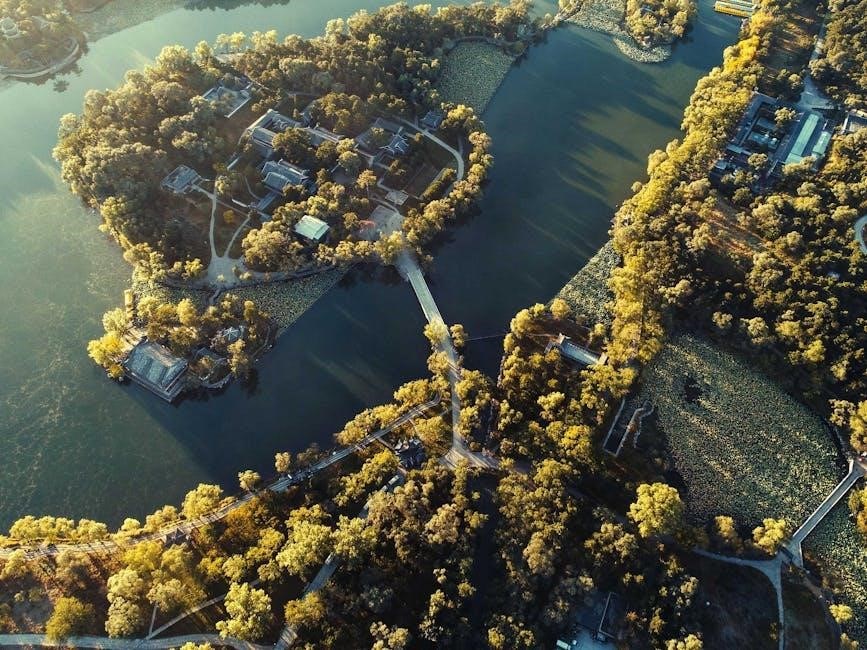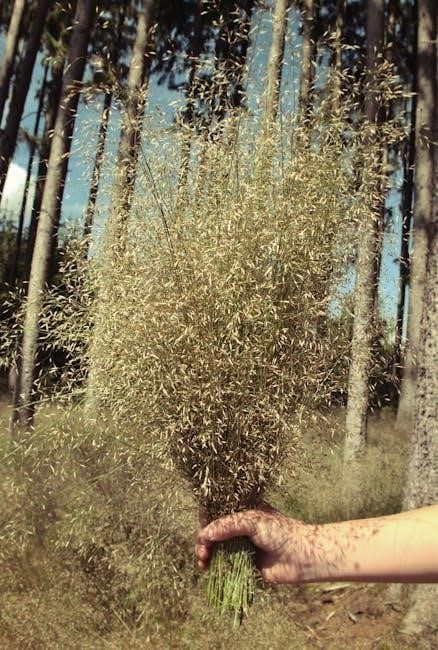Ursula K. Le Guin’s 1972 novella explores themes of environmentalism and colonialism through the clash between humans and the forest-dwelling Athsheans, whose world is deeply intertwined with nature.
Overview of the Novel
The Word for World is Forest is a thought-provoking science fiction novella by Ursula K. Le Guin, first published in 1972. The story is set in a dystopian future where humans, known as Terrans, colonize other planets to exploit their resources. The novel focuses on the planet Athshe, a world entirely covered in forest, where the indigenous inhabitants, the Athsheans, live in harmony with nature. The Athsheans’ deep connection to their environment contrasts sharply with the Terrans’ ruthless exploitation, leading to conflict and resistance. The novella explores themes of colonialism, environmentalism, and the consequences of imperialism. Originally part of the anthology Again, Dangerous Visions, it was later published as a standalone book in 1976, becoming a landmark work in the science fiction genre. Le Guin’s exploration of ecological balance and cultural clash remains deeply relevant today.
Ursula K. Le Guin and Her Work
Ursula K. Le Guin, a celebrated American author, is renowned for her thought-provoking science fiction and fantasy works. Born in 1929, she became a prominent figure in the genre, exploring themes of ecology, social justice, and human nature. Her writing often challenges societal norms and encourages readers to reflect on ethical dilemmas. The Word for World is Forest exemplifies her ability to weave compelling narratives that blend philosophy with storytelling. Le Guin’s work has been widely acclaimed, earning numerous awards and a lasting influence on literature. Her unique voice continues to resonate, inspiring new generations of readers and writers alike.
Historical Context of the Novel
The Word for World is Forest was written during a time of growing environmental awareness and anti-colonial sentiment, reflecting 1970s concerns about ecological balance and exploitation.
Publication Details
The Word for World is Forest was first published in 1972 as part of the anthology Again, Dangerous Visions, edited by Harlan Ellison. It later appeared as a standalone novel in 1976. The novella gained traction for its unique blend of ecological themes and political commentary, resonating with readers amid growing environmental concerns. The story explores the clash between human colonizers and the indigenous Athsheans, whose deep connection to their forest world contrasts sharply with the exploitative mindset of the Terrans. Available in PDF format, the book can be downloaded from various sources, including academic platforms and online libraries, making it accessible to modern readers interested in Le Guin’s visionary work. Its enduring relevance highlights the importance of environmental stewardship and cultural empathy.
Historical Influence on the Story

The historical context of The Word for World is Forest is deeply rooted in the environmental and political movements of the early 1970s. Ursula K. Le Guin wrote the novella during a time of heightened environmental awareness, following landmark events like the publication of Rachel Carson’s Silent Spring and the rise of Earth Day in 1970. The story reflects the growing concern over ecological destruction and the exploitation of natural resources, resonating with the anti-colonial and anti-war sentiments prevalent during the Vietnam War era. Le Guin’s exploration of colonialism and its impact on indigenous cultures draws parallels to historical events, offering a critique of imperialism and a call for environmental stewardship. The novella’s themes align with the broader social and political dialogues of its time, making it a significant work in the science fiction genre.

The Plot and Characters
The story unfolds on the forest-covered planet Athshe, where humans exploit the native ecosystem. The plot centers around Captain Davidson and the Athshean leader Selver, exploring themes of resistance and cultural conflict.
Setting of the Story

The story is set on the planet Athshe, a world almost entirely covered in lush, vibrant forests; This unique environment shapes the lives of the indigenous Athsheans, who live in harmony with nature. The forest is not just a physical setting but a central character, symbolizing life, spirituality, and interconnectedness. The Athsheans’ deep bond with the forest contrasts sharply with the exploitative mindset of the human colonizers, who view the planet solely as a resource to be exploited. The setting underscores the novel’s ecological themes, emphasizing the delicate balance of nature and the consequences of its destruction. This juxtaposition of environments highlights the clash between indigenous wisdom and colonial greed, making the forest a powerful symbol of resistance and survival.
Main Characters and Their Roles
The novel centers around characters like Selver, a wise and enigmatic Athshean leader, and Arnie Kott, a ruthless human colonizer. Selver embodies the deep connection between the Athsheans and their forest, leading the resistance against human exploitation. Arnie Kott represents the oppressive force of colonialism, driven by greed and disregard for the planet’s ecosystem. Other key characters include Raj Lyubov, a human anthropologist who understands the Athshean way of life, and Captain Davidson, a military officer who enforces colonial rule. These characters illustrate the clash between indigenous harmony with nature and human exploitation, highlighting the moral and ethical dilemmas central to the story.
Themes and Symbolism
The novel explores ecological balance, colonial exploitation, and cultural identity, with the forest symbolizing life, unity, and the indigenous Athsheans’ deep connection to their world.

Ecological Themes

The novel underscores the interconnectedness of life, as the Athsheans’ world and forest are inseparable; Le Guin highlights the consequences of environmental exploitation, emphasizing how the destruction of the forest threatens its inhabitants and their way of life. The delicate balance of the forest ecosystem is contrasted with the exploitative practices of the human colonizers, who prioritize resource extraction over sustainability. Through this, Le Guin critiques humanity’s tendency to dominate and destroy nature, advocating for a harmonious coexistence with the environment. The forest itself becomes a symbol of resilience and the collective consciousness of the Athsheans, illustrating the profound impact of ecological destruction on both the planet and its inhabitants. This theme remains a powerful warning about the importance of preserving natural ecosystems.
Cultural Conflict and Exploitation
The novel explores the clash between the technologically advanced Terrans and the indigenous Athsheans, highlighting themes of cultural exploitation and the consequences of imperialism. The Terrans, driven by resource extraction, disrupt the Athsheans’ harmonious existence with their environment. Le Guin portrays the exploitation as not merely physical but also cultural, as the colonizers impose their values and systems on the native population. This conflict reflects real-world issues of colonialism and the erasure of indigenous cultures. The Athsheans’ deep connection to their forest world contrasts sharply with the Terrans’ exploitative mindset, emphasizing the moral and ethical dilemmas of cultural dominance and the importance of preserving indigenous traditions and ways of life.
Resistance and Its Consequences
The Athsheans’ resistance against Terran exploitation is a central theme, highlighting the complexities of rebellion. The novel portrays the moral ambiguity of violence, as the indigenous people resort to armed struggle to protect their forest world. Le Guin explores the psychological and societal impacts of resistance, showing how it unites some while dividing others. The consequences of resistance are profound, leading to both liberation and loss. The novella underscores the high cost of fighting oppression, emphasizing that resistance, while necessary, comes with significant sacrifices. Through this, Le Guin challenges readers to reflect on the ethical dilemmas of conflict and the resilience required to preserve cultural identity and environmental harmony.
The Title: Meaning and Implications
The title reflects the Athsheans’ deep connection to their forest world, where the word for both is identical, symbolizing their inseparable bond with nature and culture.
Linguistic Significance
The title “The Word for World is Forest” highlights the linguistic and cultural duality central to the Athshean society. In their language, the same word represents both “world” and “forest,” reflecting their deep ecological harmony. This linguistic unity underscores their belief that the forest is not just a part of their world but the essence of it. The Athsheans’ worldview is deeply intertwined with their environment, and their language mirrors this inseparable bond. The title serves as a metaphor for their holistic understanding of life, where the forest is not merely a physical space but the embodiment of their culture, spirituality, and existence. This linguistic significance emphasizes the novel’s exploration of interconnectedness and the clash between indigenous harmony and external exploitation.

Philosophical Implications
The title reflects the novel’s exploration of the intricate relationship between language, culture, and environment. The Athsheans’ worldview, where “world” and “forest” are indistinguishable, embodies a philosophy of interconnectedness and harmony with nature. This linguistic and philosophical unity contrasts sharply with the exploitative mindset of the human colonizers, highlighting the clash between indigenous holism and imperialistic reductionism. The novella raises profound questions about the ethics of colonialism, the value of non-human life, and the moral imperative to preserve ecological balance. Le Guin’s work challenges readers to reconsider their relationship with the natural world, advocating for a more holistic understanding of existence and the consequences of disrupting it.

Reception and Legacy
Le Guin’s novel received critical acclaim for its thought-provoking themes and moral depth. It won the Hugo Award and influenced works like Avatar, cementing its cultural impact.
Critical Reception
Ursula K. Le Guin’s The Word for World is Forest received widespread critical acclaim for its profound exploration of ecological themes and moral complexity. Reviewers praised its thought-provoking narrative, which challenges colonial exploitation and highlights the interconnectedness of life. The novella won the Hugo Award, solidifying its place in science fiction literature. Critics noted its timely relevance, as it mirrors real-world environmental struggles. The novel’s influence extends beyond literature, inspiring works like James Cameron’s Avatar. PDF versions of the book are widely available, allowing readers to engage with its powerful message. Legal downloads ensure ethical access to this landmark work, which remains a cornerstone of eco-conscious storytelling.
Legacy and Cultural Impact
The Word for World is Forest has left an indelible mark on science fiction and environmental literature. Its exploration of colonial exploitation and ecological harmony resonated deeply, influencing works like Avatar. The novella’s themes of resistance and the interconnectedness of life continue to inspire environmental movements. PDF versions circulate widely, ensuring its message reaches new generations. Le Guin’s work remains a cultural touchstone, urging readers to reflect on humanity’s relationship with nature. Its legacy endures as a powerful call for sustainability and ethical responsibility, cementing its place as a timeless classic in both literary and ecological discourse.
Influence on Other Works
Ursula K. Le Guin’s The Word for World is Forest has profoundly influenced numerous works in science fiction and beyond. Its themes of ecological harmony and colonial resistance inspired James Cameron’s film Avatar, with striking parallels in its depiction of indigenous struggles against exploiters. The novella’s exploration of collective consciousness and environmental ethics has also shaped works by authors like N.K. Jemisin and Kim Stanley Robinson. Additionally, its critique of imperialism and advocacy for sustainability continue to resonate in contemporary literature, film, and environmental movements. The novella’s enduring relevance is evident in its adaptation into various formats, including PDF, ensuring its ideas reach a wide audience and inspire new generations of creators and activists alike.

Where to Find “The Word for World is Forest” in PDF
The novella is available as a PDF on platforms like royallib.com and manifesto-library.espivblogs.net, offering convenient access to Ursula K. Le Guin’s seminal work.
Download Options
The PDF version of Ursula K. Le Guin’s The Word for World is Forest can be downloaded from various online platforms. Websites like royallib.com offer free access to the novella in formats such as FB2, DOC, and TXT. Additionally, platforms like manifesto-library.espivblogs.net provide direct PDF downloads. Some versions may require subscription or payment, such as the GBP 23 PDF available through academic databases. Users can also explore archive.org, where a single-page processed JP2 ZIP file is available for download. Ensure to verify the legality and safety of the source before downloading. Always opt for reputable sites to avoid malware and respect copyright laws.
Legal and Ethical Considerations
Downloading The Word for World is Forest in PDF format requires adherence to copyright laws. The novella is copyrighted, and unauthorized distribution or downloading from illegal sources is prohibited. Users should opt for legal platforms that offer the book, such as purchasing from official retailers or accessing it through subscription-based services. Libraries and educational institutions often provide legitimate access to the text. Supporting the author and publisher by obtaining the book legally ensures ethical consumption and respects intellectual property rights. Always verify the source’s legitimacy to avoid legal consequences and promote a fair literary ecosystem.
The Word for World is Forest remains a timeless critique of environmental exploitation and cultural conflict, urging readers to reflect on humanity’s relationship with nature and ethics.
Final Thoughts

Ursula K. Le Guin’s The Word for World is Forest is a profound exploration of environmentalism, colonialism, and resistance, offering timeless lessons on humanity’s relationship with nature. The novel’s depiction of the clash between progress and preservation resonates deeply, urging readers to reflect on the consequences of exploitation. The Athsheans’ deep connection to their forest world serves as a powerful metaphor for indigenous cultures and ecological harmony. As a PDF, the book remains accessible, allowing readers to engage with its themes and reflect on their relevance today. It is a reminder of the importance of ethical stewardship and the resilience of those who fight to protect their world.
References for Further Reading
For those interested in exploring The Word for World is Forest further, various resources are available. The novella can be downloaded as a PDF from platforms like royallib.com and manifesto-library.espivblogs.net. Additionally, academic analyses, such as D. Barnhill’s 2010 work, provide deeper insights into the novel’s themes. The book was originally published in the anthology Again, Dangerous Visions in 1972 and later as a standalone novel in 1976. Readers can also access the novella through platforms like Archive.org, which offers multiple formats, including PDF. These resources allow for a comprehensive understanding of Le Guin’s work and its cultural significance.